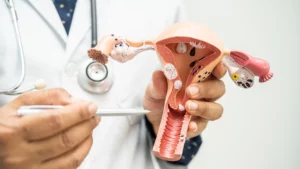Uterine polyps, those pesky, abnormal growths of the endometrium, can cause a host of discomforts—unusual bleeding, irregular menstrual cycles, and sometimes, even fertility concerns. When a decision is made to remove these polyps, often through a procedure known as hysteroscopic polypectomy, it naturally leads to questions about when to expect your period after a uterine polyp removal.
Understanding the intertwining relationship between uterine interventions and menstrual health is essential for women navigating their post-surgery journey. So, when to expect your period after a uterine polyp removal?
Normal Menstrual Cycle
Before diving into post-surgery expectations, let’s first get a baseline understanding. A typical menstrual cycle lasts anywhere from 21 to 35 days, and it’s divided into phases:
- The menstrual phase
- The follicular phase
- Ovulation
- The luteal phase
Each phase plays a role in preparing the uterus for potential pregnancy or shedding the lining (endometrium) when pregnancy doesn’t occur, which results in menstruation.

Impact of Uterine Polyp Removal on Menstrual Cycle
The procedure to remove a polyp halts the monthly buildup and breakdown of the endometrial tissue, at least temporarily. This operation can directly impact the lining, possibly leading to a lighter or a skipped period immediately post-surgery.
However, it’s important to understand that the uterine lining is remarkably resilient and typically resumes its regular cycle soon after healing.
Read More: What are Uterine Polyps, Symptoms, Causes and Treatment?
Factors Affecting the Return of Menstruation
Every woman’s body is unique, with recovery times varying greatly due to factors such as:
- Personal healing rates
- Age and pre-surgery menstrual regularity
- Hormonal balance
- Overall health and lifestyle
Surgery might be a resetting event for the menstrual cycle, but the resilience of the menstrual process means that most women should not expect significant long-term changes in their cycle due to polyp removal.
When to Expect Your Period After a Uterine Polyp Removal?
On average, women can anticipate their first period to return within 4 to 6 weeks post-surgery. However, some may experience their first period sooner or later than this general range.
Factors such as the extent of the surgery and how much endometrial tissue was removed can contribute to this variability.
While the 4 to 6-week timeframe is an average, if your period hasn’t returned after 8 weeks and pregnancy has been ruled out, it’s wise to consult with your healthcare provider.
They might want to assess your hormonal levels, review healing progress, and rule out any complications that could be affecting your menstrual cycle.
Keep track of any symptoms, changes, or concerns, and don’t hesitate to reach out to your doctor with questions or for advice specific to your situation.

Monitoring Menstrual Changes
Post-surgical care includes monitoring your cycle, which can offer insights into your recovery and overall menstrual health. Women should watch for:
- The heaviness of the flow
- Consistency of the cycle
- Any new or worsening symptoms
Don’t hesitate to contact your healthcare provider with any abnormalities, as they can best assess and provide guidance based on individual circumstances.
Read Also: Weight Loss After Uterine Polyp Removal
Conclusion
While some variability in the menstrual cycle is common after uterine polyp removal, most women can expect a return to normalcy within a couple of menstrual cycles. Patience and vigilance are key during recovery, coupled with open communication with your healthcare provider.
Equipped with the information above, you’re better prepared for the road to recovery. Your period may dance to a different rhythm immediately after surgery, but with time, you can expect the music to return to its familiar tempo.
By proactively taking charge of your health, tracking changes, and seeking medical advice when necessary, you can navigate the post-surgical experience with confidence and return to your rhythm in no time.
FAQs
Q: Is it normal to miss my period entirely after a uterine polyp removal?
A: Yes, it’s normal for some women to experience a missed period, or a significantly lighter one, after surgery. If you’re concerned about any changes, consult your doctor.
Q: What signs should I look for that indicate a problem after my surgery?
A: Unusual symptoms like excessive bleeding, severe pain, fever, or foul-smelling discharge should prompt a visit to your healthcare provider.
Q: Can uterine polyp removal affect my fertility?
A: Many women have polyps removed as part of fertility treatments. Removing polyps can improve uterine health and potentially increase the chances of conception.
Q: How long should I wait after surgery before contacting my doctor about menstrual changes?
A: If you have not had a period after six weeks, or if you experience any concerning symptoms before that time, reach out to your healthcare provider.
Q: Can uterine polyps recur even after they’ve been removed?
A: Yes, there’s a possibility of polyps redeveloping, which is why regular check-ups are important post-surgery.






